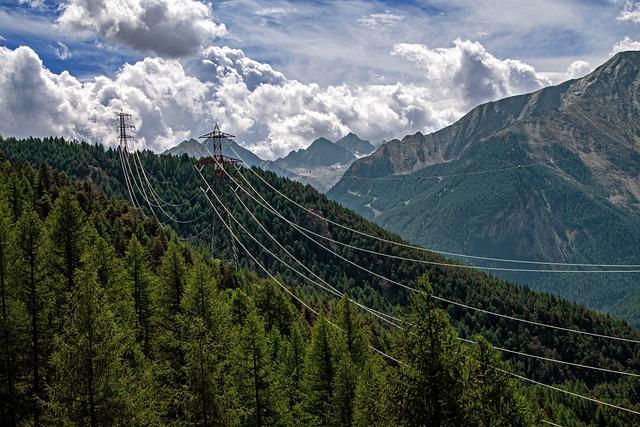Trees are not just majestic beings that provide shade and oxygen; they are complex organisms with intricate physiological processes crucial for their survival. Understanding tree physiology is key to improving forest management practices and ensuring the health and longevity of these essential components of our ecosystem. In this article, we delve into the science of tree physiology, exploring the inner workings of trees and the factors that influence their growth, development, and overall well-being.
Table of Contents
- Understanding the Role of Leaves in Photosynthesis
- The Importance of Root Structure and Function
- Water Transport Mechanisms in Trees
- How Temperature Affects Tree Growth and Development
- The Influence of Light on Tree Health and Growth
- Q&A
- Conclusion
Understanding the Role of Leaves in Photosynthesis
Leaves play a crucial role in the process of photosynthesis, which is essential for the survival of plants. These green structures contain chlorophyll, a pigment that absorbs sunlight and converts it into energy for the plant. The veins in leaves also help transport water and nutrients throughout the plant, supporting its growth and development.
In addition to producing energy for the plant, leaves also release oxygen as a byproduct of photosynthesis. This vital gas is then used by humans and other animals for respiration, highlighting the interconnectedness of all living organisms on Earth. As such, leaves are not only important for the health of individual plants but also for the overall ecological balance of our planet.
The Importance of Root Structure and Function
Root structure and function are essential components of tree physiology. The roots of a tree are responsible for anchoring it into the ground, providing stability and support as it grows and develops. In addition, the root system absorbs water and nutrients from the soil, which are crucial for the tree’s overall health and growth.
Understanding the intricacies of root structure and function is important for arborists and researchers alike. By examining the root system of a tree, experts can assess its overall health and diagnose any potential issues that may be affecting its growth. Additionally, studying root structure can help us better understand how trees interact with their environment and adapt to different soil conditions.
Water Transport Mechanisms in Trees
are a fascinating aspect of tree physiology that play a crucial role in the survival and growth of these magnificent organisms. One of the key processes involved in water transport is transpiration, which is the movement of water from the roots up through the plant and out into the atmosphere through tiny pores in the leaves called stomata. This process helps to regulate the water balance within the tree and is essential for nutrient uptake and photosynthesis.
Another important mechanism of water transport in trees is capillary action, which allows water to move upwards through the xylem vessels in the tree against gravity. This process relies on the cohesive and adhesive properties of water molecules, as well as the structure of the xylem cells, to create a continuous column of water from the roots to the leaves. Additionally, root pressure can also play a role in water transport in some tree species, where water is pushed upwards from the roots into the stem and leaves due to osmotic forces.
Understanding the intricate can provide valuable insights into how these organisms function and adapt to their environment. By studying these processes, researchers can gain a better understanding of how trees respond to changes in water availability, temperature, and other environmental factors, ultimately helping us to better appreciate and protect these essential components of our natural world.
| Transpiration | Movement of water from roots to leaves through stomata |
| Capillary Action | Upward movement of water through xylem vessels via cohesive and adhesive properties |
| Root Pressure | Pushing water upwards from roots into stem and leaves due to osmotic forces |
How Temperature Affects Tree Growth and Development
Temperature plays a crucial role in tree growth and development, as it directly impacts physiological processes within the tree. Fluctuations in temperature can influence everything from photosynthesis to water uptake, ultimately affecting the overall health of the tree.
**Key Points on :**
- **Photosynthesis:** Warmer temperatures can increase photosynthesis rates, leading to more efficient energy production for the tree.
- **Respiration:** Higher temperatures can also accelerate respiration rates, affecting how the tree processes energy and nutrients.
- **Cold Stress:** Extreme cold temperatures can cause damage to tree tissues, impacting growth and development.
| Temperature Range | Effect on Tree Growth |
|---|---|
| Optimal | Enhances growth and development |
| Extreme Heat | Can lead to stress and decreased growth |
| Extreme Cold | May cause damage and stunted growth |
The Influence of Light on Tree Health and Growth
When it comes to the health and growth of trees, light plays a crucial role in their physiology. Light is one of the essential factors that determine the overall well-being of trees, influencing their ability to photosynthesize, grow, and thrive in their environment.
**Key Points:**
- Light is essential for photosynthesis, the process by which trees convert sunlight into energy.
- Strong and direct sunlight promotes healthy growth and development in trees.
- Shade-tolerant trees have adapted to thrive in low-light conditions by maximizing their use of available light.
| Light Level | Effect on Trees |
|---|---|
| High Light | Encourages vigorous growth and fruit production. |
| Low Light | Slows growth but promotes survival in shade-tolerant species. |
| Dappled Light | Provides a balance of light and shade for optimal tree health. |
Q&A
Q: What is tree physiology?
A: Tree physiology is the study of how trees function and respond to their environment at the cellular and molecular level.
Q: What are some key factors that influence tree physiology?
A: Factors such as sunlight, water availability, temperature, soil nutrients, and genetics all play a role in the physiology of trees.
Q: How do trees transport water from the roots to the leaves?
A: Trees use a system called xylem to transport water from the roots to the leaves. Xylem is made up of tiny tubes that carry water and nutrients throughout the tree.
Q: What is photosynthesis and how does it relate to tree physiology?
A: Photosynthesis is the process by which trees convert sunlight into energy. This process is crucial for tree growth and is a key component of tree physiology.
Q: How do trees respond to stress, such as drought or disease?
A: Trees have various mechanisms to cope with stress, such as closing their stomata to conserve water during drought, or producing phytochemicals to defend against pathogens.
Q: How can an understanding of tree physiology benefit forestry and conservation efforts?
A: By understanding tree physiology, foresters and conservationists can better manage forests, predict how they will respond to environmental changes, and develop strategies to protect and preserve tree species.
Conclusion
In conclusion, understanding the science of tree physiology is essential for effectively managing and preserving our forests. By delving into the intricate processes that occur within trees, researchers and conservationists can better comprehend how these incredible organisms function and adapt to their environments. With this knowledge, we can work towards implementing more sustainable practices that will help ensure the health and longevity of our forests for generations to come. Stay tuned for more fascinating insights into the world of tree physiology and its implications for the future of our planet.
Simpsons Tree Services, Servicing Melbourne’s North Eastern Suburbs
Book a quote online at www.simpsonstrees.com.au




